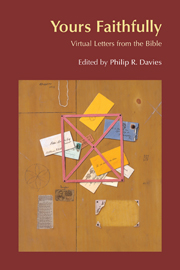Book contents
- Frontmatter
- Contents
- INTRODUCTION: IN PRAISE OF VIRTUAL LETTERS
- 1 Sarah to Abraham
- 2 Isaac to Abraham
- 3 Sarah to Rebekah
- 4 Pharaoh Ramses to Moses
- 5 Aaron to Miriam
- 6 Jephthah's Daughter to her Father
- 7 Samson to Delilah
- 8 Shmuel ben Elkanah to Achish
- 9 Absalom to David
- 10 Salu Father of Zimri to Zur Father of Cozbi
- 11 Ahitophel to Absalom
- 12 Ahitophel to Eliam, his Son
- 13 King Ahab to his Steward Obadiah
- 14 King Ahab to the Writers of the Books of Kings
- 15 Athaliah to Elijah the Tishbite
- 16 The Big Fish to Jonah
- 17 Nineveh to Judah
- 18 Jeremiah to Ezekiel
- 19 Between Zedekiah and Jeremiah
- 20 Haggai to Zechariah
- 21 Zechariah to Haggai
- 22 Esther to her Mother
- 23 John the Baptizer to Jesus
- 24 Jesus to his Mother
- 25 Judas Iscariot to James; James to his Family
- 26 From a Greek Woman of Tyre to Jairus of Galilee
- 27 Pilate's Wife to her Husband
- 28 Publius Philostratus to an Author
- 29 Onesimus to Paul
- 30 ‘Jezebel’ of Thyatira to John of Patmos
- 31 Letter to Bible Authors [Draft]
- List of Authors
24 - Jesus to his Mother
- Frontmatter
- Contents
- INTRODUCTION: IN PRAISE OF VIRTUAL LETTERS
- 1 Sarah to Abraham
- 2 Isaac to Abraham
- 3 Sarah to Rebekah
- 4 Pharaoh Ramses to Moses
- 5 Aaron to Miriam
- 6 Jephthah's Daughter to her Father
- 7 Samson to Delilah
- 8 Shmuel ben Elkanah to Achish
- 9 Absalom to David
- 10 Salu Father of Zimri to Zur Father of Cozbi
- 11 Ahitophel to Absalom
- 12 Ahitophel to Eliam, his Son
- 13 King Ahab to his Steward Obadiah
- 14 King Ahab to the Writers of the Books of Kings
- 15 Athaliah to Elijah the Tishbite
- 16 The Big Fish to Jonah
- 17 Nineveh to Judah
- 18 Jeremiah to Ezekiel
- 19 Between Zedekiah and Jeremiah
- 20 Haggai to Zechariah
- 21 Zechariah to Haggai
- 22 Esther to her Mother
- 23 John the Baptizer to Jesus
- 24 Jesus to his Mother
- 25 Judas Iscariot to James; James to his Family
- 26 From a Greek Woman of Tyre to Jairus of Galilee
- 27 Pilate's Wife to her Husband
- 28 Publius Philostratus to an Author
- 29 Onesimus to Paul
- 30 ‘Jezebel’ of Thyatira to John of Patmos
- 31 Letter to Bible Authors [Draft]
- List of Authors
Summary
The letter text is reconstructed by Konstantin von Tischentuch from fragments he discovered in a cluster of graves near ancient Edessa. The letter was also known in early Christianity: Eusebius succeeded in extracting the letter from the archives of Edessa where it was kept together with the only other extant letter by Jesus. But as the Church Fathers, headed by Augustine and Jerome, reached a decision that Jesus himself was too illiterate to leave anything in writing (and so by divine providence the formation of christological doctrine was conveniently left to them), the letters were deemed to be false or ‘apocryphal’ and disappeared into oblivion until von Tischentuch's rediscovery.
The letter text is fragmentary, and the context of the missing fragments could indicate that they were perhaps removed intentionally.
The letter is translated from Syriac. The fact that both the extant letters by Jesus are written in this language is a strong indication that Syriac was the language Jesus himself spoke, not Aramaic as is commonly assumed.
Dear Mum,
I really […]
as I typed this, a little square angel with a blue face popped up on my screen and said ‘It looks like you're writing a letter. Would you like help?’ I am not really good at writing, in fact I have done it only once before, and then Ananias the courier helped me, so I have opted to ‘get help with writing the letter’.
- Type
- Chapter
- Information
- Yours FaithfullyVirtual Letters from the Bible, pp. 121 - 126Publisher: Acumen PublishingPrint publication year: 2004

